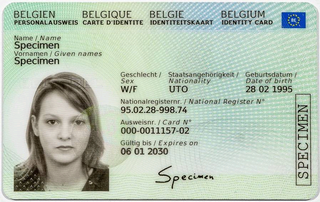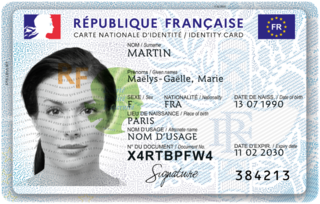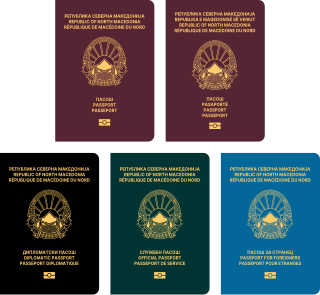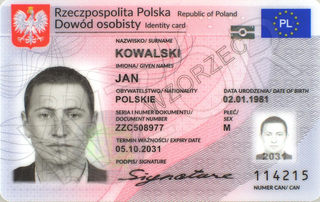An identity document is any document that may be used to prove a person's identity. If issued in a small, standard credit card size form, it is usually called an identity card, or passport card. Some countries issue formal identity documents, as national identification cards that may be compulsory or non-compulsory, while others may require identity verification using regional identification or informal documents. When the identity document incorporates a person's photograph, it may be called photo ID.
A national identification number, national identity number, or national insurance number or JMBG/EMBG is used by the governments of many countries as a means of tracking their citizens, permanent residents, and temporary residents for the purposes of work, taxation, government benefits, health care, and other governmentally-related functions.

A Belgian identity card is a national identity card issued to all citizens of Belgium aged 12 years old and above.

The French national identity card is an official identity document consisting of an electronic ID-1 card bearing a photograph, name and address. While the identity card is non-compulsory, all persons must possess some form of valid government-issued identity documentation.

The Hong Kong identity card is an official identity document issued by the Immigration Department of Hong Kong. According to the Registration of Persons Ordinance, all residents of age 11 or above who are living in Hong Kong for longer than 180 days must, within 30 days of either reaching the age of 11 or arriving in Hong Kong, register for an HKID. HKIDs contain amongst others the name of the bearer in English, and if applicable in Chinese. The HKID does not expire for the duration of residency in Hong Kong.

The Republic of China national identification card, commonly known as the national identification card of Taiwan, is a compulsory identity document issued to people who hold both nationality and household registration in Taiwan. The National Identification Card served as the evidence for the household registration in Taiwan which grants the holder the right of abode and full civil and political rights in Taiwan. The card is used for virtually all other activities that require identity verification within Taiwan such as opening bank accounts and voting.

The Swedish national identity card is a non-compulsory biometric identity document issued in Sweden. It is one of two official identity documents issued by the Swedish Police, the other being the Swedish passport. It is only issued to Swedish citizens, and indicates the citizenship.

North Macedonian passport are issued to citizens of North Macedonia for the purpose of international travel. Responsibility for their issuance lies with the Ministry of the Interior. The validity of the passport is 5 years for persons 4 to 27 years of age and 10 years for those 27 years of age and older. For children ages four and under, the validity of the passport is limited to two years. The passports conform to the recommended standards of the International Civil Aviation Organization (ICAO), and are biometric passports.

The Polish Identity Card is a national identity document issued to Polish citizens. As Poland is a European Union member state it is also serves a European Identity card. Every Polish citizen 18 years of age or older residing permanently in Poland is required to have an identity card issued by the local office of civic affairs. Children as well as Polish citizens living permanently abroad are entitled, but not required, to have one. Identity cards are valid for a period of 10 years.

The Italian electronic identity card, or simply carta d'identità, is an identification document issued to any Italian citizen and to legal aliens, that has been progressively replacing the paper-based identity card since version 3.0 was first released on 4 July 2016. The CIE is intended for both digital and physical identification. The biometric information is printed on an ID-1 card and stored in a contactless chip.

The Macau Resident Identity Card or BIR is an official identity card issued by the Identification Services Bureau of Macau. There are two types of Resident Identity Cards: one for permanent residents and one for non-permanent residents.

The Documento Nacional de Identidad (DNI) or carnet de identidad is a national identity document compulsory to all citizens of Spain aged fourteen and above. It has a personal, unique and exclusive identification number or número de DNI –made up of eight digits plus a control letter– that is assigned to the holder the first time he/she obtains the document and that keeps throughout his/her life as a general identifier.

The Bulgarian identity card is a compulsory identity document issued in Bulgaria. The document is issued by the police on behalf of the Ministry of Interior and is the main form of identification on the territory of the Republic of Bulgaria. All Bulgarians are obliged by law to carry their identity cards with them at all times and are subject to fines should they not.

The Moldovan identity card, from 2025 – is a compulsory identity document issued in the Republic of Moldova. Every Moldovan citizen who resides in the Republic of Moldova must have an ID card. Moldovan ID cards are issued by the Public Services Agency. The following are required to have an ID card: from birth until 10 years of age, from 10 years of age until 16, from 16 years of age until 25, and from 25 years of age until 45. After 45 years of age, the ID card is not required to be renewed.

The German Identity Card is issued to German citizens by local registration offices in Germany and diplomatic missions abroad, while it is produced at the Bundesdruckerei in Berlin.

The Cypriot identity card is issued to citizens of Cyprus. It can be used as a travel document when visiting countries in Europe, as well as French overseas territories, Montserrat and Georgia. This document is not valid in Turkey.
The Lebanese identity card is a compulsory Identity document issued to citizens of the Republic of Lebanon by the police on behalf of the Lebanese Ministry of Interior or in Lebanese embassies/consulates (abroad) free of charge. It is proof of identity, citizenship and residence of the Lebanese citizens.

The national identity cards are identity documents issued to citizens of nations in the European Union (EU) and European Free Trade Association (EFTA) member states, with the exception of Denmark and Ireland. The identity cards have been harmonized as a new common identity card model replaced the various formats in use on 2 August 2021.

The Norwegian identity card, commonly referred to as the national identity card in Norway, is a non-compulsory biometric identity document issued since 30 November 2020. It is one of two official identity documents issued by the Norwegian Police Service, the other being the Norwegian passport. It is only issued to Norwegian citizens, and may indicate citizenship so that it can be used as a travel document facilitating freedom of movement within the European Free Trade Association and the European Economic Area. For travel within the Nordic countries no identity documentation is legally required for Nordic citizens due to the Nordic Passport Union.

The Icelandic identity card, is a voluntary identity document issued by Registers Iceland since 12 April 1965. It is one of three official identity documents issued by the Icelandic Government, along with the Icelandic passport and Icelandic driving licence. It is only issued to Icelandic citizens regardless of age and may indicate citizenship, so that it can be used as a travel document facilitating freedom of movement within the European Free Trade Association and the rest of the European Economic Area. For travel within the Nordic countries no identity documentation is legally required for Nordic citizens due to the Nordic Passport Union.





















